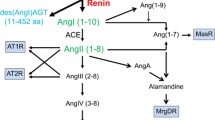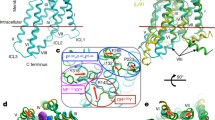Abstract
Proton magnetic resonance and chemical reactivity studies have demonstrated the presence of a tyrosine charge relay system in angiotensin which is analogous to the serine charge relay system present at the active site of serine proteases. Receptor activation by angiotensin can be explained by electronic effects deriving from an interaction of the charge relay system with stacking of the histidine and phenylalanine rings. Experiments with serine protease inhibitors suggest the possibility that mechanistic features of the interaction of angiotensin with its receptors may apply to other ‘phenoxyl’ hormones including certain peptides, steroids and catecholamines.
Similar content being viewed by others
References
Turker LF, Hal MM, Yamamoto M, Sweet CS & Bumpus SM (1972). Science177, 1203–1205.
Scanlon MN, Matsoukas JM, Franklin KJ & Moore GJ (1984) Life Sci.34, 317–321.
Matsoukas JM, Scanlon MN & Moore GJ (1984) J. Med. Chem.27, 404–406.
Glickson JD, Cunningham WD & Marshall GR (1973) Biochemistry12, 3684–3692.
Goren HJ & Fridkin M (1974) Eur. J. Biochem.41, 263–272.
Freer RJ & Stewart JM (1973) J. Med. Chem.16, 733–736.
Weinkam WJ & Jorgensen C (1971) J. Am. Chem. Soc.93, 7033–7038.
Weinkam WJ & Jorgensen C (1971) J. Am. Chem. Soc.93, 7038–7044.
Matsoukas JM & Moore GJ (1984) Biochem. Biophys. Res. Commun.122, 434–438.
Moore GJ & Matsoukas JM (1984) In: Peptides 1984 (Proc. 18th Eur. Pept. Symp.) (Ragnarsson U, ed), pp 615–619, Almqvist and Wiksell, Stockholm.
Moore GJ (1984) submitted for publication.
Smeby RR & Fermandjian S (1978) In: Chemistry and Biochemistry of Amino Acids, Peptides and Proteins (Weinstein B, ed), vol. 5, pp 117–162, Marcel Dekker, New York.
Blow DM, Birktoft JJ & Hartley BS (1969) Nature221, 337–339.
Schiller PW (1977) Can J. Biochem.55, 75–82.
Matsoukas JM, Goghari MH, Scanlon MN, Franklin KJ & Moore GJ (1985) J. Med. Chem., in press.
Brock TA & Smith JB (1984) Adv. Exp. Med. Biol.172, 435–454.
Kwok YC & Moore GJ (1980) Mol. Pharmacol.18, 210–214.
Larsson LE, Lindeberg G, Melin P & Pliska V (1978) J. Med. Chem.21, 352–356.
Bisset GW, Clark GJ, Krejci I, Polacek I & Rudinger J (1970) Brit. J. Pharmacol.40, 342–360.
Deslauriers R & Smith I. C. P. (1963) Biochem. Biophys. Res. Commun.40, 179–185.
Schoellmann G & Shaw E (1963) Biochemistry2, 252–259.
Baker ME & Fanestil DD (1977) Nature269, 810–812.
Baker ME & Fanestil DD (1981) Biochem. Biophys. Res. Commun.98, 976–982.
Author information
Authors and Affiliations
Rights and permissions
About this article
Cite this article
Moore, G.J., Matsoukas, J.M. Angiotensin as a model for hormone — receptor interactions. Biosci Rep 5, 407–416 (1985). https://doi.org/10.1007/BF01116558
Received:
Issue Date:
DOI: https://doi.org/10.1007/BF01116558




